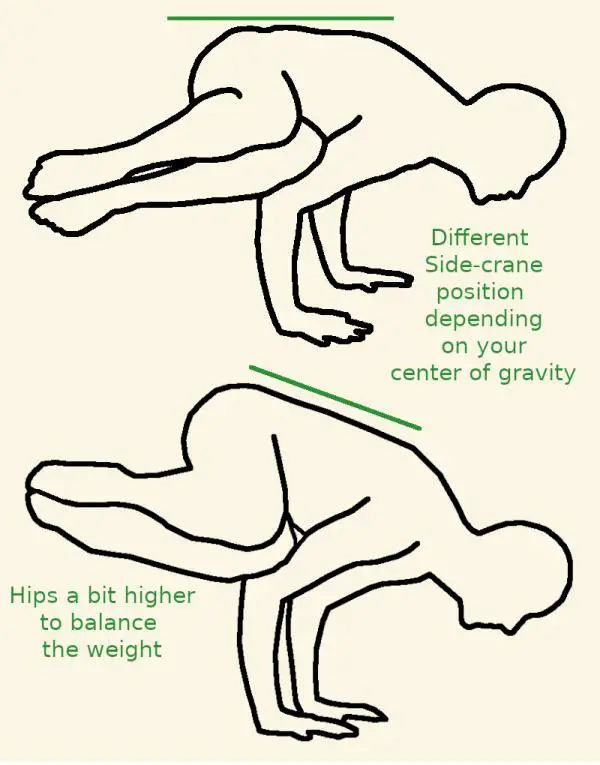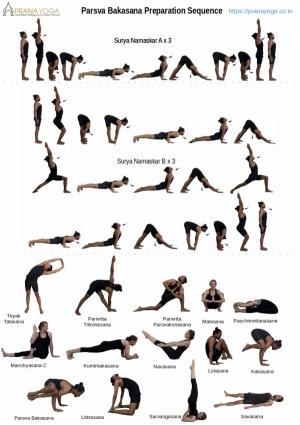Parsva bakasana (side crane pose) is an intermediate-level pose that requires a mix of strength and flexibility. While Kakasana (the crow pose)mostly requires strength in the arms, and shoulders and the core parsva bakasana requires flexibility in the hips in squatting direction and twisting along with the strength in the arms, shoulders, and the core.
Whether you are doing a self-practice or making a sequence for your students these logical steps of how to sequence postures for a particular asana would help you a lot. If you are including any asana which might be a bit difficult then prior preparation for that asana will increase the chances of you getting into the posture. While most yoga postures can have variations depending on your level, the arm balancing postures have a few to no variations. You are either in the balance or you are not, but you can keep preparing and finally you will get it. Consistent practice is the key.
**Read about proper hand placement and alignment for arm balancing postures to keep your wrists safe and injury-free.
Before starting the physical practice, analyzing/studying the pose is also a part of the preparation. what do we mean by this? There is always mechanics involved in a posture. If you develop this skill of “seeing the mechanics of a posture” you will know what alignment is required for a posture. But this will take time and can only come with practice and study.
For arm balancing postures this mechanics involves gravity. While doing arm balancing think of a weighing scale, both sides need to be balanced. Similarly in parsva bakasana the front of the body and the back of the body both need to be balanced. And for different people, this balanced posture might look slightly different depending on where they carry more weight. Males generally have a heavier upper body and for females, it’s the lower body. So the side crane for someone might be flatter than some other. A person with a heavier lower body might need to bring their hips a bit higher so as to shift the weight forward. The sketch below will give you a better idea.

**A suggestion: look do an image search of parsva bakasana on google and analyze the posture of different people, especially if you are a Yoga teacher or want to be one.
You can apply this same concept in many other postures.
Another important study is about the wrists. Our wrist is generally not used to bear so much load, so a proper understanding of how to engage the muscles is required. Here the mechanics involved is Newton’s third law of motion (every action has an equal and opposite reaction).
What do you need to do if I ask you to stand tall? If you observe then you find out that you push your legs into the ground which helps you to engage the core and your whole body gets a bit taller.
Are you actually getting taller? well, the bones are definitely not growing, you are engaging your muscles which creates more space in your joints. The same force with which you are pushing the ground becomes available to you, which lifts you up, aligns your body, and makes more space in the joints.
Try to use this same concept in the arm balancing postures. Engage your fingers and press them into the ground, engage your core (uddiyana bandha- the flying lock) and work on lifting yourself up (imagine that you need to lift your hips at least one more centimeter high), this will create more space in the joints (mostly the wrist joint) and keep them healthy.
Sometimes out of laziness or not paying attention we let ourselves sink into the postures. We do not engage our muscles and completely rely on the bones. The bones are for support and muscles for strength. If we rely only on the bones then under the weight of the body the bones might sink into the joints decreasing the gap and gradually creating some kind of injury.
Another important pointer is not to get into the posture by doing a jumping kind of motion. Rather try to get into the posture by shifting your weight.
Now let’s talk about the sequence and an explanation of why we have added the various parts in the sequence.
- Joint rotations – A very important part to keep the joints healthy and in the optimal range of motion, we have skipped this part in the sequence and assume that you would already be knowing and doing these simple exercises.
- Warm-up – this is the most important part. whether you are able to do the posture you are preparing for or not, warmups get the blood flowing and remove the stiffness from the muscles, making it safer to use for difficult postures.
- Flexibility – Working on the flexibility of those areas which might be required to perform the theme posture (side crane).
- Core work – We need to tighten and fire up the core muscles which will be required for the theme posture (side crane).
- Backbends – Releasing the tightness created from all those core work.
- Inversions – Required to slow down the breath and balance the energy.
- Relaxation – Grounding yourself and balancing the energy.
Here is the sequence, You can also download a bigger pdf version of the sequence

If you are looking for more sequences, check our sequences page.